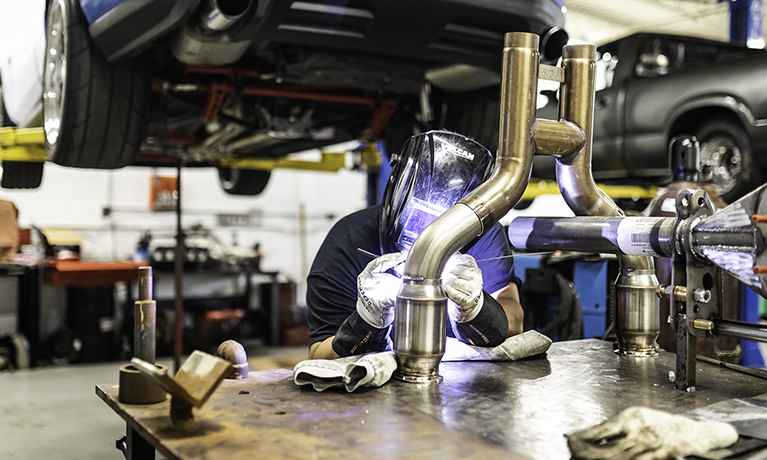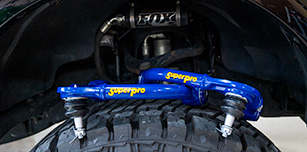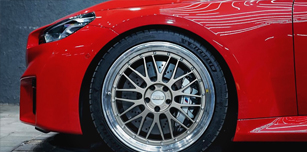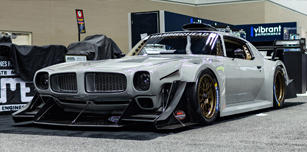Ever since the first catalytic converter was required in the American automotive marketplace 45 years ago, automotive enthusiasts have been looking for a way to gain back the lost power these components gobble up as a function of their operation. Nearly every single gasoline-powered automobile must have them to comply with the Environmental Protection Agency (EPA) and its regulation of vehicle exhaust emissions. During most of this period, people simply took them off, choosing to run the risk of being discovered at inspection time and hoping to get a pass from the inspector, or even reinstalling the converters just ahead of inspection and then removing them for the rest of the year. Not only does this break the law, but it’s also just plain bad for the environment. We recently installed a set of headers into a vehicle, but the catalyst-equipped crossover pipe was out of stock, so we made the decision to develop our own. That’s where G-Sport Emissions Systems comes in, as its catalytic converters are purpose-built and performance-friendly for enthusiast use.
“G-Sport exists because the automotive high-performance industry has never had a purpose-built high-performance catalytic converter to use in their exhaust systems. Historically, the industry has repurposed converters that were designed for use in OEM or OEM-replacement applications, but there was never a product designed to support the horsepower and offer a complementary driving experience while meeting the EPA or regulatory standard,” says G-Sport’s Albert Reda.




The catalytic converters work correctly even on forced-induction vehicles without producing excessive backpressure and power loss. Not only are they designed specifically for these applications, but they are also EPA-compliant for use on OBD-I and OBD-II vehicles without issue.
With the help of Chris at Maher Automotive, we recently installed a set of G-Sport’s High Output catalytic converters onto a project vehicle using a set of V-band connectors from site sponsor Vibrant Performance for simplicity and ease of future removal of the H-pipe.




For education’s sake, let’s take a look at the construction of the catalytic converters to gain an understanding of how they function, and why G-Sport’s design is notable for today’s enthusiasts.
Every catalytic converter has one function — to take the engine’s harmful emission gases and convert them into less-harmful inert gases. Automotive catalytic converters are three-way converters because they perform three tasks at once: reduce nitrogen oxides to nitrogen, promote oxidation of carbon monoxide into carbon dioxide, and promote oxidation of unburnt hydrocarbons to carbon dioxide and water.
These reactions are most efficient when the engine is run just above the stoichiometric point, which is equivalent to a 14.7:1 air/fuel ratio for pump gasoline. The reactions occur most efficiently when the exhaust gas composition flips between rich (too much fuel) and lean (too much oxygen), over and over again during engine operation.


G-Sport converters are simple: they utilize a substrate core manufactured from furnace-brazed 304 stainless steel, a proprietary wash coat technology that deposits the precious metals required for conversion onto the substrate most efficiently, and in-house canning processes designed to lock the catalytic core into place inside the housing.
“The exhaust restriction has historically been the catalytic converter. As horsepower thresholds have increased, the positive is that in today’s world, the catalytic converter does very little to hinder the horsepower gains at the highest end. But more importantly, the emissions control system is important to today’s generation of enthusiasts,” explains Reda.




The emissions reduction capabilities of G-Sport’s converters are impressive: up to 99 percent reduction of carbon monoxide (CO), 98 percent reduction of nitrogen oxide (NOx), and hydrocarbon emissions reduction up to 95 percent over a vehicle not using converters.
G-Sport currently manufactures two different versions of its EPA-compliant converter: High Output (HO) and Ultra High Output (UHO) units. The HO version is produced in 2.50-inch and 3.0-inch inlet/outlet sizes with a body diameter of 4.0 inches, along with a core-only version. These offer a cell density of 300 per square inch and can handle 350–500 horsepower per exhaust bank. The UHO units are available in 3.0-inch and 4.0-inch inlets in a 4.50-inch body. The big boys support 500–850 horsepower per engine bank. These converters have a minuscule horsepower tax—Reda says the number is virtually negligible and often within the margin of error on a chassis dyno—which means that there’s no reason to avoid using catalytic converters anymore on a street car. The HO version was selected for this car as they support the vehicle’s power level, with the size needed to clear the frame as seen above.
“The metallic foil is the modern approach to substrate manufacturing. We form our own foil and furnace-braze every contact point. We use two to three strips of nickel, line the entire foil with the nickel strip, then furnace-braze it to the exterior canister. The foil is capable of withstanding high-horsepower and high torque,” says Reda.
“Our cell design flows better than most other comparable 300-cell designs. The most important reason why we push the 300-cell design in a universal cat is that if we made a 200-cell design, the exhaust gases would flow too freely through the coated areas and wouldn’t have enough residence time within the cell to effectively convert the gas. It needs to stay within the body for some amount of time for the chemical reaction to occur.”
As the cell population density is reduced, more heavy metals are required to produce the proper chemical reaction to convert the gases. There has to be a design balance to the process to make a converter that is affordable, upholds the quality standards set at G-Sport, and meets or exceeds the regulatory requirements.


They even offer two converters that are non-EPA-compliant for applications where a stock catalytic converter was not provided from the OEM (1973 and older) as well as any off-road application, such as on trail or race-only vehicles. These converters use catalysts that have a lighter load of precious metals, and are ideal for use in classic car applications, where they can become an effective solution for eliminating black smoke and foul odor from your exhaust gas. They are meant for all engines, but will not meet EPA requirements.
These G-Sport catalysts were installed into an existing 3.0-inch stainless steel H-pipe, which required a fair bit of fabrication. Chris tackled this with ease, methodically following each step to ensure a leak-free seal that would last for years to come. The simplest way to perform the installation was to weld the male side of the Vibrant V-band connector to the end of the header, measure and cut the H-pipe, set it into place, tack the female V-Band flange to the H-pipe, then remove the H-pipe to TIG-weld everything together. He uses many Vibrant products in his shop, both on his X275 car along with plenty of installations on customer vehicles; he commented about how easily everything went together.





Since the headers were already in the vehicle, Chris decided that it made sense to drop the transmission crossmember to tilt the headers down toward the ground so he could get to the tops of the collectors to weld them closed. Even so, he still opted to weld the very tops of the V-bands from inside the collector rather than the outside, as the TIG torch didn’t fit between the exhaust and the body of the vehicle.
Now that the converters are installed, we can note that there is a slight reduction of volume at startup, and the raw fuel smell that permeated everything pre-installation is now gone. Power does not seem to be affected whatsoever, according to the butt-o-meter. Although there might be a slight change if we had measured on a dyno, it’s more important to do the right thing for the environment. Flawless installation, fit, and finish. Two thumbs up!



















